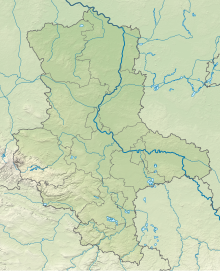Collar tear
Coordinates: 51 ° 50 ′ 36 " N , 12 ° 22 ′ 49" E
The collar crack (referred to as "collar crack" in the nature conservation ordinance) is a nature reserve in the town of Oranienbaum-Wörlitz in the Wittenberg district in Saxony-Anhalt .
The nature reserve with the registration number NSG 0096 is 217 hectares . It is almost completely part of the FFH area "Desslau-Wörlitzer Elbauen" and the EU bird sanctuary "Middle Elbe including Steckby-Lödderitzer Forest" and is completely surrounded by the landscape protection area "Middle Elbe". The area has been under protection since the end of 2003 (date of regulation: December 15, 2003). It replaces the nature reserve of the same name, which was designated on May 1, 1961. 54 hectares of the nature reserve are left to natural development as a total reserve . The responsible lower nature conservation authority is the Wittenberg district.
The nature reserve is located between Vockerode and Wörlitz , districts of Oranienbaum-Wörlitz, in the Elbe River Landscape Biosphere Reserve . It places a section of the landscape on the Middle Elbe with the waters of Kronen and Riss as well as adjacent areas under protection. The rift is the mouth of the river ditch and is therefore subject to flood events in the Elbe . The collar is separated from the Elbe and Riss by a dike. It is fed via several trenches and drained via the Kapengraben to the Mulde . Both waters are dammed. The part of the Stromelbe in the area of the city of Oranienbaum-Wörlitz is included in the nature reserve.
The shore areas of collars and tear are of large reeds and sedge from reed , broadleaf cattail , Ästigem bur-reed , water vapors , Schlanksegge and reed canary grass coined. Various aquatic plant communities with comb spawn , streaky spawn , hairy spawn , Canadian waterweed and yellow pond rose settle in the waters . In small dike excavation holes z. B. Specular pondweed and spring moss . In particular, collars and central wood trenches that border the area to the east are accompanied by wood on the banks. In the south-east of the nature reserve and north of the Riss, alluvial forest remnants with cane grass communities in damp depressions and hornbeam communities on higher areas. Grow on the edges of woods hornbeam -Schlehen-bushes and hems with Hain Wachtelweizen . Herbaceous corridors are u. a. formed by long-leaved speedwell , marsh wolf milk and ciliated ragweed . On the sandy dykes, populations of black fescue and red fescue grow.
The nature reserve is the habitat of the Elbe beaver . The waters and bank areas are the habitat of the great crested grebe , the little grebe , water rail , marsh harrier , common snipe , kingfisher , reed warbler and reed warbler . In the forest areas live u. a. Red and black kite , middle woodpecker , reversible neck , oriole and nuthatch . The nightingale is also native to the nature reserve.
During bird migration, the nature reserve is a resting area for large populations of different species of ducks, some of which also overwinter here, including teal , teal , wigeon , pintail , shoveler , pochard and tufted duck . Mute swan , whooper swan and goosander also rest here . The nature reserve is also used by sea eagles and ospreys to search for food.
Between the collar and the crack, as well as between the remains of the alluvial forest and the Mittelhölzergraben, grassland and arable land are included in the nature reserve. The grassland areas are partially designed as grass clown Silauwiesen. In many cases , agricultural areas border the nature reserve, and further forests to the north.
Web links
Individual evidence
- ↑ Order No. 1 on nature reserves , Journal of Laws of the German Democratic Republic, May 4, 1961 (PDF, 101 kB). Retrieved April 17, 2018.



